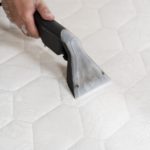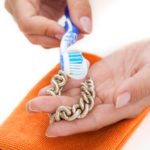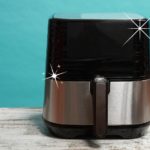Cleaning lampshades might be a task that’s very low down on your cleaning list. The job isn’t exactly difficult to carry out. It’s just not given much attention.
Consequently, dust and general grime build up on the surfaces rather quickly and make the once-pleasing shades drab and dreary!
Ensuring your lampshades are clean will make them more aesthetically pleasing. Plus, well-maintained shades ensure that plenty of light flows through your rooms.
So, how do you keep lampshades clean? Follow the steps below.
How Often Should You Clean a Lampshade?
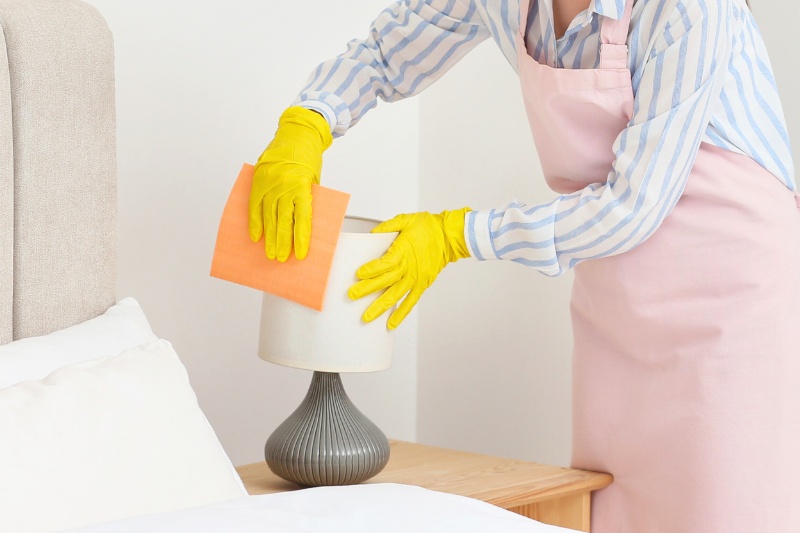
Ideally, you should dust your lampshade(s) weekly to keep everyday dirt and dust at bay.
A quick clean once a week keeps the cobwebs away and stops a whole load of gunk from forming on the shade’s surface and making it look yucky.
Plus, if you stay on top of the general cleaning, you won’t have to do deep cleans as often.
If by some chance your lampshade(s) get stained, you should treat the blemish immediately so it doesn’t have time to age and toughen up.
Mature marks are often troublesome to remove and, in some of the worst cases, cannot be taken out.
Deep cleans should be completed every three months. But as mentioned, this deep clean won’t take you too long if you maintain your shades every week.
In addition, where your lampshades are located will affect how often they need to be cleaned. For example, a lampshade in a kitchen will need to be cleaned more frequently because it is exposed to smells and grease.
But again, regular maintenance should prevent a considerable build-up of dirt on the kitchen shade.
How to Clean a Lampshade
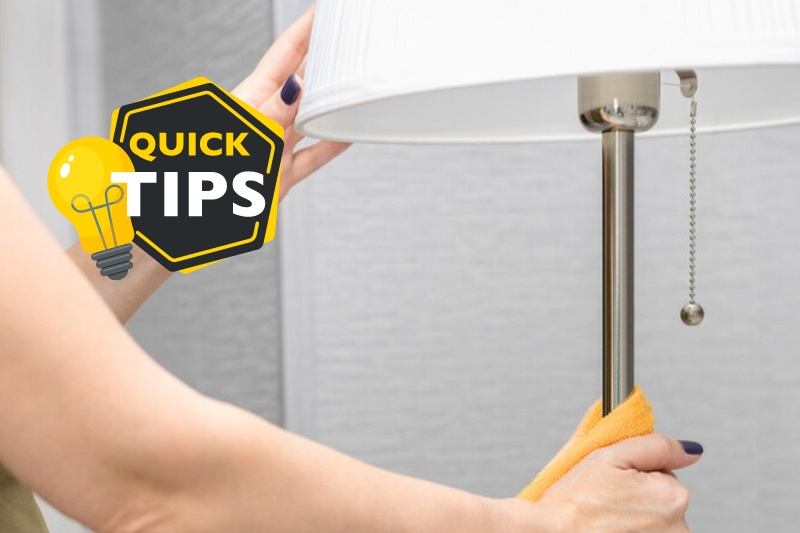
Tips to consider
Here are a few points to think about:
- Unplug the lamp and remove the lampshade before you clean it.
- Test your chosen cleaning solution before you use it.
- Make sure you clean the outside and inside of the lampshade.
- Don’t wet your lampshade unless you’re told it is safe to do so.
- Be very careful when cleaning a lampshade. You’re working around electricity!
- Make sure the lampshade is dry before you reattach it to the lamp.
- Find out what your lampshade is made from and clean it in an appropriate manner.
- Avoid chemical-laden cleaners like bleach and ammonia. Stick to using mild detergents and soft cleaning tools.
- Read the care label on the lampshade to find out how it needs to be cleaned.
- Always take a gentle approach when cleaning any type of lampshade. Hard scrubbing movements can seriously damage or warp shades. So, take your time and don’t apply too much pressure to the delicate surface.
- Use canned air to tease hard-to-get-to dust from nooks and crannies.
- Don’t stick a lampshade of any material in a dishwasher or washing machine to clean it. The harsh agitation and heat will warp, shrink or completely break the shade.
Identify what type of lampshade you have
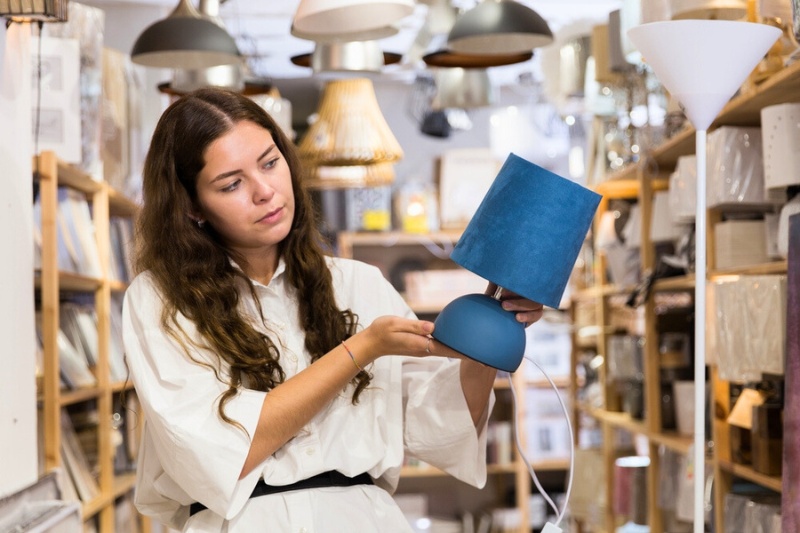
The most common kinds of lampshade are:
- Fabric
- Paper
- Plastic
- Glass
- Metal
- Rattan
- Wicker
- Silk
Sometimes lampshades will come with patterns, pleats and lace trims. Shades can also be vintage/antique and need specialist care.
Now you know what lampshades can be made from. You can skip to the section that applies to your lampshade and clean it accordingly. See below.
Fabric lampshades

Tools you’ll need:
- Lampshade
- Neutral-coloured microfibre cloths
- Optional: Lint roller
- Optional: Feather duster
- Optional: Hoover with upholstery attachment
- Tub
- Warm water
- Woolite detergent
- Teaspoon
- Towel
- Optional: Hanger
Steps to follow:
- Make sure there is no power going to the bulb in the lampshade.
- Grab a microfibre cloth, lint roller or duster and dust the entire shade. You can also vacuum the shade using the upholstery attachment on a hoover, but ensure the suction is low and don’t press down too hard.
- Check the care tag and stick to the advice you’re given. If possible, hand wash your lampshade following the steps below.
- Fill a sink, bucket or bathtub (something big enough to hold the shade) with warm water – not boiling.
- Add two teaspoons of Woolite detergent to the water.
- Slosh the water around to mix in the detergent.
- Remove the lampshade from the lamp. The lampshade should not be attached to any electrical source.
- Re-dust the lampshade.
- Hold the shade by the wires and place it gently into the water.
- Wait 10 minutes (adjust if need be).
- Move the lampshade around so each part gets soaked in the soapy water.
- Grab a neutral-coloured microfibre cloth.
- Soak the cloth in the water.
- Wipe the shade with the cloth. Go from top to bottom. Do inside and outside.
- For tough dirt, put a blob of Woolite on the cloth and carefully rub the stain.
- Empty the dirty water out of the tub and refill it with clean water.
- Rinse the lampshade in the water to remove the soap.
- Repeat Steps 16 and 17 until all the soap is gone.
- Shake the lampshade and place it on a flat towel to dry, or clip a hanger onto the metal wires to hang the shade up.
- Reattach the shade to the lamp when it’s dry!
Tip: If your lampshade has an intricate pattern or pleats, use a clean toothbrush to tease out the dust.
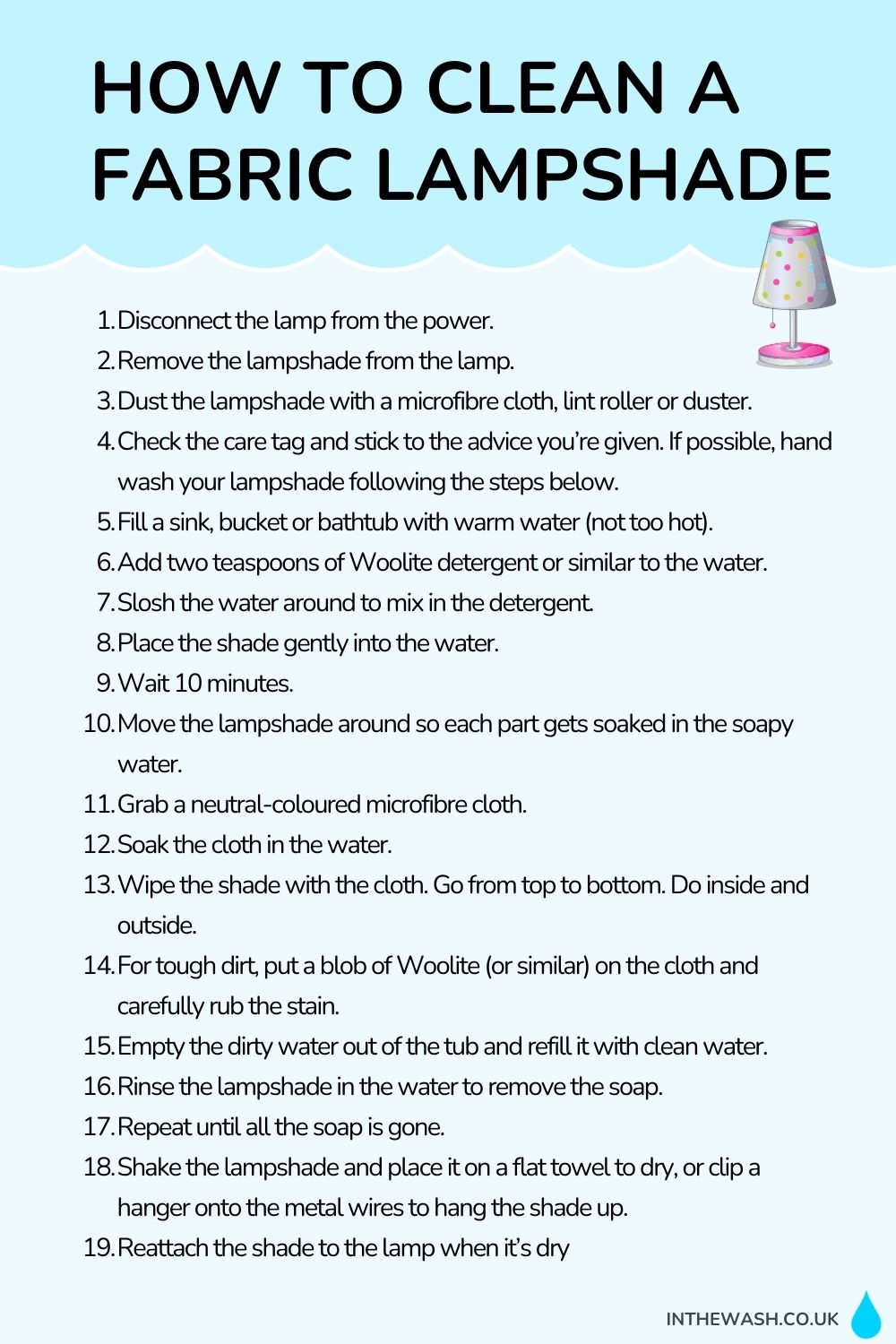
Paper lampshades
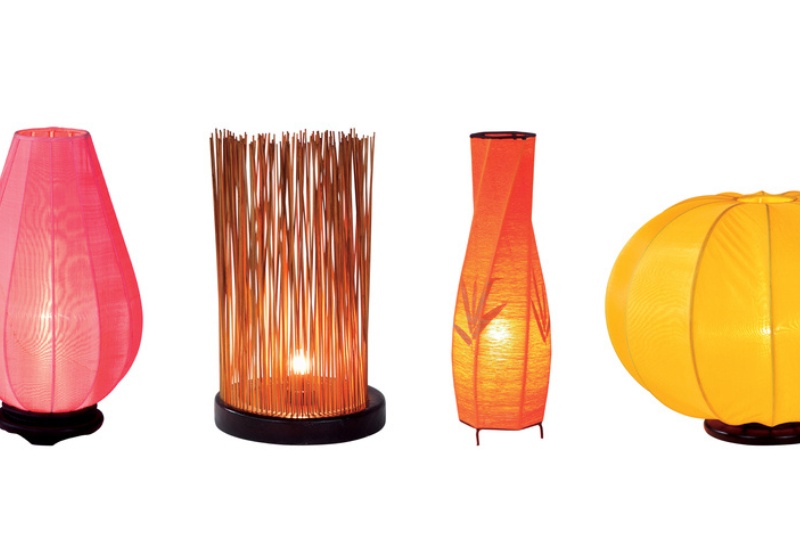
Tools you’ll need:
- Neutral-coloured microfibre cloths
- Rubber
Steps to follow:
- Make sure there is no power going to the bulb in the lampshade.
- Grab a microfibre cloth and dust the entire shade, inside and out.
- If there are stains on the paper lampshade, grab a neutral-coloured rubber and carefully rub the blemishes away. Always support the shade when doing this.
You must be extra careful when cleaning paper lampshades because they are fragile. The lampshade cannot be cleaned with water either. Liquids can rip or break down the paper shade, making it unusable.
Plastic or glass lampshade
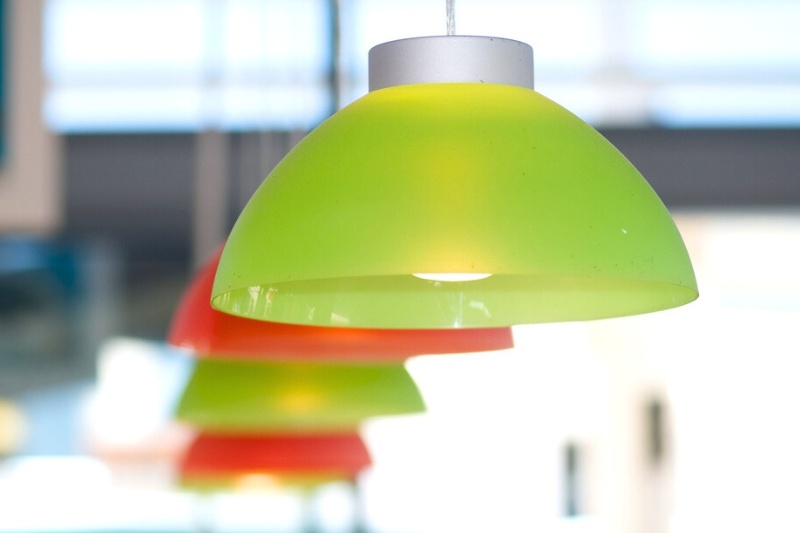
Tools you’ll need:
- Neutral-coloured microfibre cloths
- Tub
- Warm water
- Washing up liquid
Steps to follow:
- Ensure the shade is cool before you touch it. Leave the light off for a few hours before you clean the lampshade.
- Remove the lampshade from the lamp.
- Use a clean, dry microfibre cloth to remove the dust from the lampshade. Clean inside and outside.
- Fill a sink with warm water – make sure the water isn’t boiling. If the water is too hot, the shade could crack.
- Pop a few blobs of washing up liquid into the water.
- Slosh the water around to mix in the cleaner.
- Pop the lampshade in the water.
- Grab a microfibre cloth (no abrasive tools!) and start cleaning the whole shade, inside and out.
- Rinse the suds off the lampshade and dry it with a clean, dry microfibre cloth.
- Replace the shade when it’s completely dry.
Metal, rattan or wicker lampshade
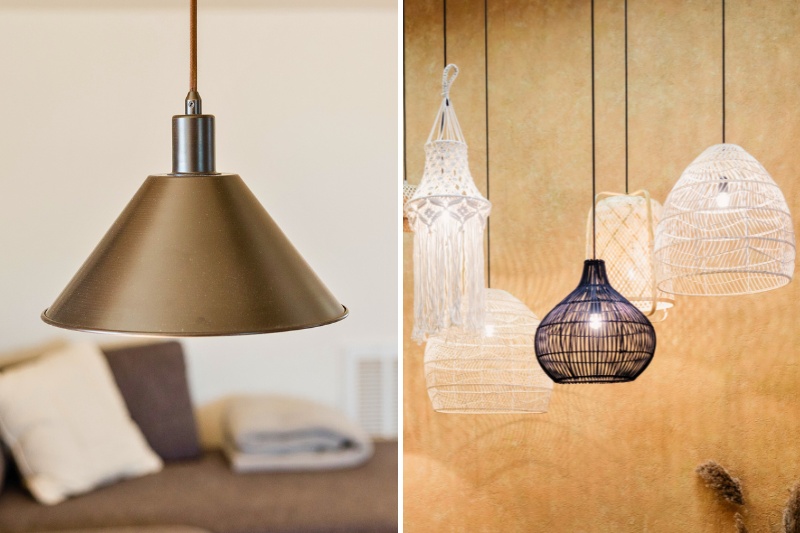
Tools you’ll need:
- Neutral-coloured microfibre cloths
- Toothbrush
- Warm water
- Washing up liquid
- Bowl
Steps to follow:
- Ensure the shade is cool before you touch it.
- Remove the lampshade from the lamp.
- Use a clean, dry microfibre cloth to remove the dust from the shade. Clean inside and outside. A toothbrush can also be used to dislodge grime.
- Fill a bowl with warm water. Make sure the water isn’t boiling.
- Pop a few blobs of washing up liquid into the water.
- Slosh the water around to mix in the cleaner.
- Grab a microfibre cloth and dip it into the water.
- Wring the microfibre cloth out.
- Start cleaning the whole shade, inside and out.
- Rinse the suds off the lampshade with a second damp microfibre cloth.
- Dry the shade with a clean, dry microfibre cloth.
- Replace the shade when it’s completely dry.
Tip: Don’t use heavy-duty chemicals or abrasive tools, as they could damage the materials.
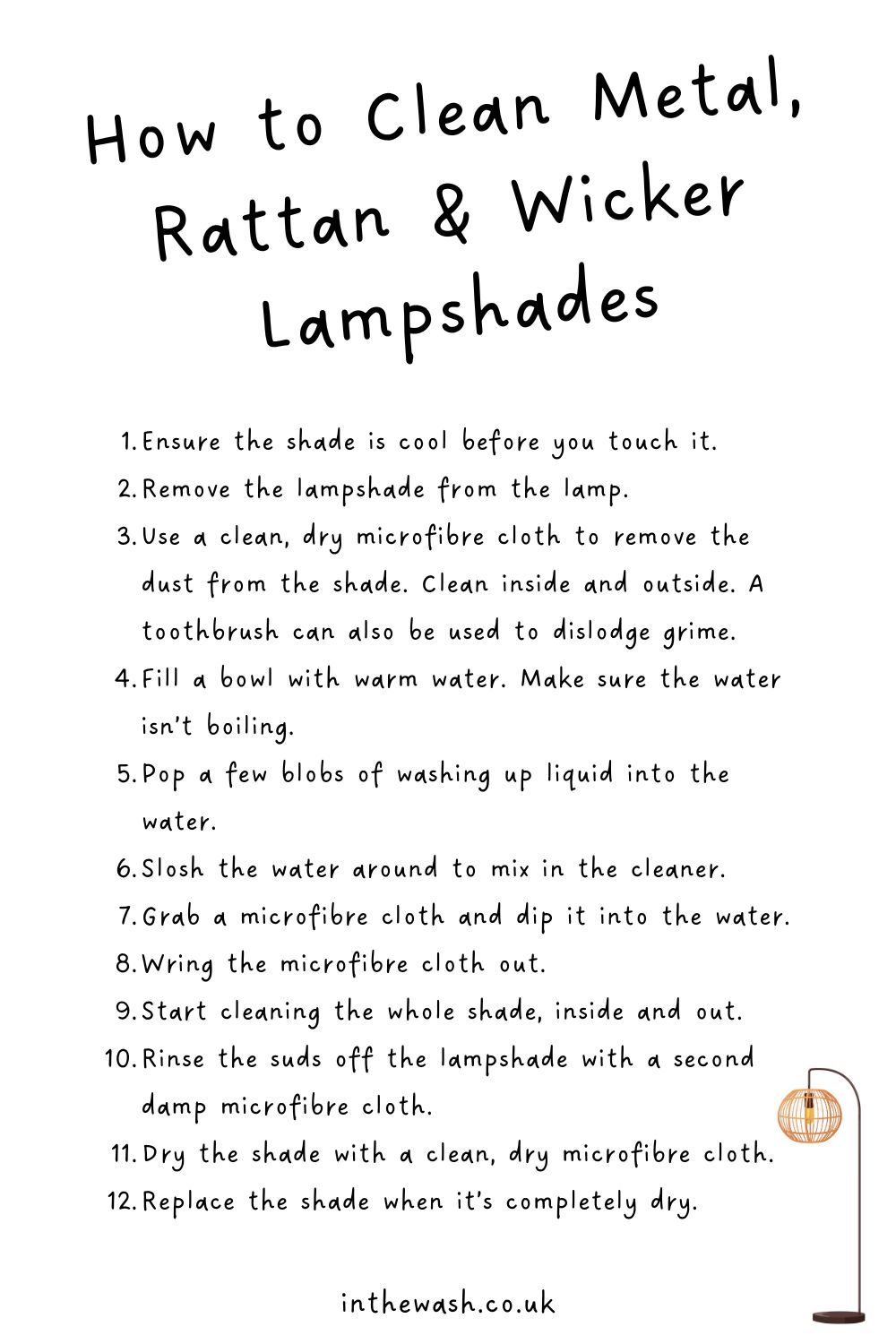
Lampshades that are vintage or made from a delicate material
If you’ve got a particularly old lampshade or a very expensive one, you may not be keen on the idea of cleaning the shade yourself. In this case, you should call a professional to help you.
How to Clean Dirty White Lampshades
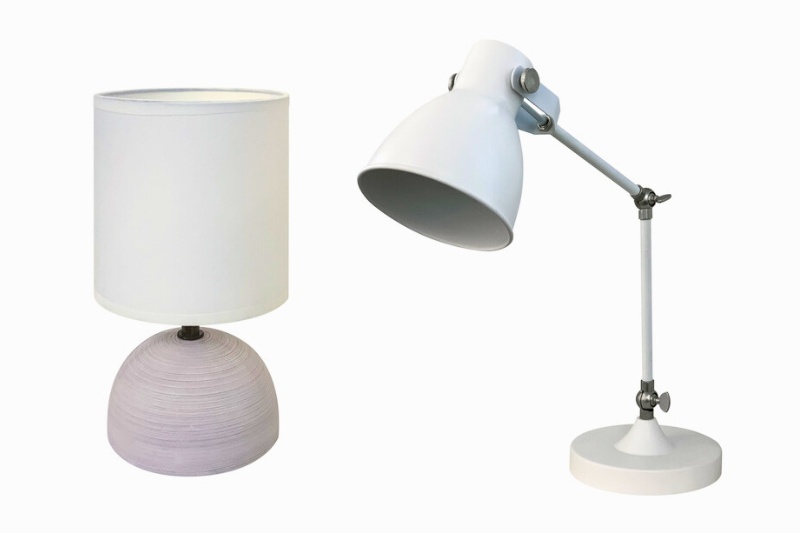
White lampshades are known for gathering grime and showing it off. So, how do you fix your grotty white lampshade?
If you’ve got a fabric shade, follow this method: Coat the blemished areas in a bicarbonate of soda and water paste and allow it to rest on the surface for 15 to 20 minutes. Then, rinse the paste off and allow your shade to dry.
If you’ve got a paper shade, follow this method: Grab a white rubber and carefully rub the marks off the lampshade. Make sure you support the lampshade during this process, or you risk ripping the shade.
How to Keep Lampshades Clean
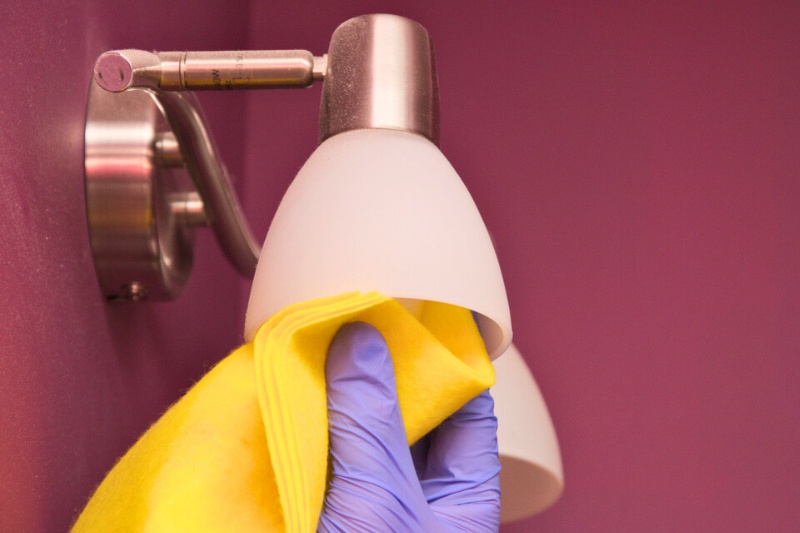
Lampshades will inevitably get bogged down with dust, cobwebs, pollen, oily fingerprints, insects, food, and greasy smears.
You can’t protect your shades all the time. You can, however, reduce how dirty they get.
Here are some points to keep in mind so you can keep your lampshades fresher for longer:
- The easiest way to keep your lampshades clean is to regularly maintain them by dusting/wiping them each week. By doing this, you can keep the dirt at bay, and you won’t have nasty, gunky build-ups to deal with!
- Ensure you clean your shades in a way that suits the material they’re made out of.
- Try to avoid touching the lampshade itself. This should limit the possibility of greasy fingerprints plaguing the surface.
- Treat stains straight away so they don’t have time to solidify and become an eyesore.
What Are the Signs That You Need to Replace a Lampshade?
Some common signs that it is time to get a new lampshade include:
- You’ve cleaned your shade multiple times, and no amount of cleaning can remove the grime from it.
- The lampshade is going yellow, and your treatments aren’t reversing this discolouration.
- The shade is falling apart. For example, the glue is failing in certain parts.

Bethan has a passion for exploring, reading, cooking and gardening! When she’s not creating culinary delights for her family, she’s concocting potions to keep her house clean!


